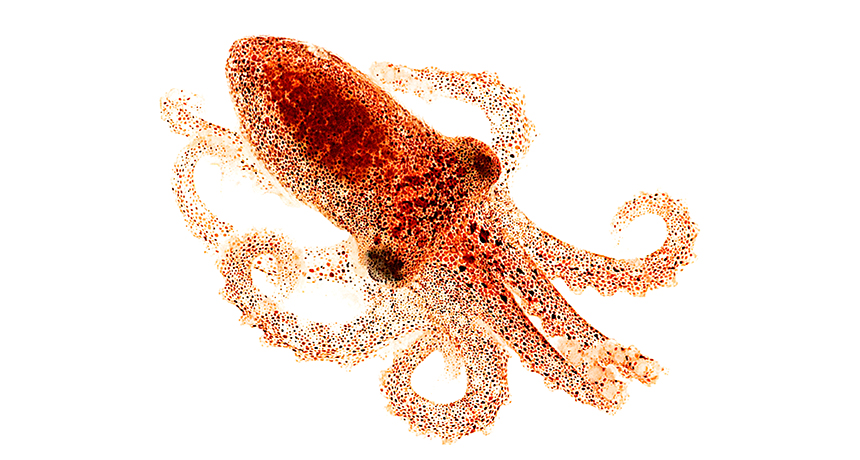Octopuses can ‘see’ with their skin
Detecting light away from eyes can trigger animals’ color changes

SKIN THAT SEES The California two-spot octopus (hatchling shown) can detect light with just its skin — no eyes or brain necessary — and respond with a color change display.
Markos Alexandrou
Octopus skin can detect light and respond to it — no eyes or brain required.
Tests of fresh skin samples from California two-spot octopuses (Octopus bimaculoides) show this ability clearly for the first time in any cephalopod, says Todd Oakley of the University of California, Santa Barbara. White or blue light prompts the pale skin’s tiny quick-change color organs, or chromatophores, to expand, creating waves of yellows and browns.
The octopus tests, along with another research team’s new studies of two kinds of cuttlefishes and a squid, feed discussion about whether light detection in places other than eyes plays some role in cephalopods’ changing color displays. All four species studied have light-sensing compounds in tissues beyond their eyes, the two teams report May 15 in the Journal of Experimental Biology.
Biologists have known that eyes and the central nervous system have a major influence on prompting color displays that camouflage octopuses or let them communicate. A paper in 1993 foreshadowed this, reporting that octopus skin itself also seemed to respond to light, Oakley says. His coauthor and UCSB colleague Desmond Ramirez worked for months determining that light triggers a color-change display in detached octopus skin samples. The eyes’ main light-sensing protein, one of many forms of opsin, may have gained another function in skin as a sensor for light, the researchers speculate.
That idea fits with Ramirez’s discovery that blue-green light prompts the quickest start for the skin samples’ color changes. The light isn’t very different, just 10 nanometers longer in wavelength, from the blue light (470 nanometers) that most strongly stimulates the eyes’ opsin. Genes known to encode compounds that work with opsin also turn on in the octopus skin, the experiments show.
Opsins operating beyond the eyes might offer local refinements to camouflage or even help the animals sense other environmental cues such as pressure. Intriguing ideas, but “it’s early days,” Oakley cautions.
Opsins and compounds that work with the proteins also show up in skin from the common and broadclub cuttlefishes (Sepia officinalis and S. latimanus) and the longfin inshore squid (Doryteuthis pealeii), Thomas Cronin of the University of Maryland, Baltimore County and his colleagues report. The combination of compounds represents the first molecular evidence that opsins are functioning in the skin of these species. Also, molecular evidence suggests a location in the skin: the chromatophores.
So far, though, there’s no evidence in squids and cuttlefishes that light striking skin is enough to make chromatophores blush. Cronin isn’t completely ruling out the idea yet and speculates about more subtle roles. “Maybe they don’t respond directly, but they may alter a signal sent from the central nervous system,” he says.
Research on light detection beyond eyes and brains “has been neglected for some time,” says developmental biologist Florian Raible of the University of Vienna. Yet non-eye light sensing structures or compounds show up in the tube feet of sea urchins and the body walls of fruit fly larvae. And in Raible’s lab, a polychaete worm flees light — even after beheading.
CHANGING ITS SPOTS Seen through a microscope (first at natural speed, then at half speed), a bit of skin removed from an octopus does not react to red light. But when white light shines on it, dotlike color-change organs expand, turning yellow or brown. Researchers call this process LACE for light-activated chromatophore expansion. Courtesy of Robyn Crook.







